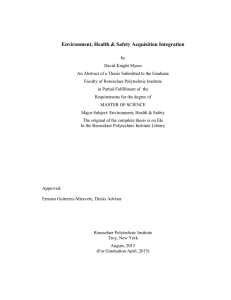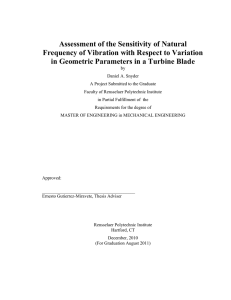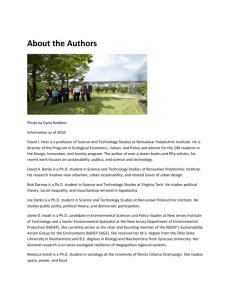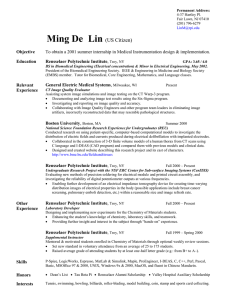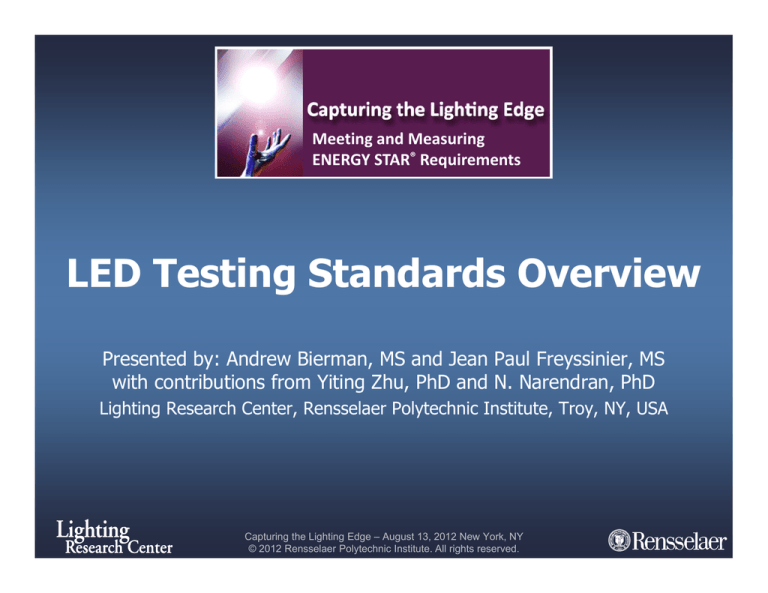
Meeting and Measuring ENERGY STAR® Requirements
LED Testing Standards Overview
Presented by: Andrew Bierman, MS and Jean Paul Freyssinier, MS
with contributions from Yiting Zhu, PhD and N. Narendran, PhD
Lighting Research Center, Rensselaer Polytechnic Institute, Troy, NY, USA
Capturing the Lighting Edge – August 13, 2012 New York, NY
© 2012 Rensselaer Polytechnic Institute. All rights reserved.
Outline
Background
› Relative vs. absolute photometry
LED photometric testing standards:
›
›
›
›
IES
IES
IES
IES
LM-79-08
LM-80-08
TM-21-11
LM-82-12
General questions and answers
Capturing the Lighting Edge – August 13, 2012 New York, NY
© 2012 Rensselaer Polytechnic Institute. All rights reserved.
Relative and Absolute Photometry
Relative Photometry:
› Output is relative to an easily-measured
condition
› E.g., bare lamp operated on a reference
ballast, base up at 25°C
› Specific lamp performance doesn’t matter
Absolute photometry:
› Output is measured in calibrated units
under specific operating and environmental
conditions
• Orientation
• Input voltage
• Ambient temperature
CFL
› Lamp and system performance matters
Capturing the Lighting Edge – August 13, 2012 New York, NY
© 2012 Rensselaer Polytechnic Institute. All rights reserved.
3
Relative and Absolute Photometry
Absolute is more difficult because:
Need to maintain flux standards and calibrate equipment
› Calibrate with incandescent, measure other SPDs and directional light
sources
Sampling concerns
› How many? How to choose? Are samples representative?
Must reproduce environmental and operating conditions
while maintaining calibrated equipment
› Temperature, input voltage or current (driver)
Comfortable and accurate at 25° C, but
how to take measurements at 85° C?
Capturing the Lighting Edge – August 13, 2012 New York, NY
© 2012 Rensselaer Polytechnic Institute. All rights reserved.
4
Relative and Absolute Photometry
Relative photometry is used to simplify testing
› Works well when the system is well defined and characterized
• E.g., linear fluorescent lamp systems
– Flux = (rated lumens) x (ballast factor) x (luminaire efficiency)
› Does not work well for making comparisons across different
systems
• E.g., CFL replacements for incandescent lamps
– Geometry issues, lack of reference ballast definitions, temperature
effects
› Useful for measuring variations under different testing
conditions
• Light output over time
• Elevated temperature
Capturing the Lighting Edge – August 13, 2012 New York, NY
© 2012 Rensselaer Polytechnic Institute. All rights reserved.
5
Standard Test Methods for LED Products
Standard
Method
Purpose
IES LM-79-08
Absolute
Light output, efficacy,
color for LED products
IES LM-80-08
Relative
Light output over time,
temperature for LED
packages
IES LM-82-12
Relative
(references LM-79)
Light output, efficacy,
color over temperature for
light engines
IES TM-21-11
Calculation, modeling
Extrapolating LM-80 test
data to predict life
ANSI/UL 153:2002 (Secs. Portable Electric
Luminaires
124-128A)
ANSI/UL 1574:2004 (Sec. Track Lighting Systems
54)
ANSI/UL 1598:2008 (Secs. Luminaires
19.7, 19.10-16)
Methods for in-situ
temperature method
(ISTM) testing for
EnergyStar
Capturing the Lighting Edge – August 13, 2012 New York, NY
© 2012 Rensselaer Polytechnic Institute. All rights reserved.
IES LM-79-08
Approved method: Electrical and Photometric
Measurements of Solid-state Lighting Products
Capturing the Lighting Edge – August 13, 2012 New York, NY
© 2012 Rensselaer Polytechnic Institute. All rights reserved.
Scope LM-79-08
Solid-state lighting products for illumination purposes
Complete systems with electrical drivers and heat sinks
› Powered by AC mains or dc voltage
Measurements under standard conditions
›
›
›
›
Total luminous flux
Electrical power, input voltage and current
Luminous intensity distribution
Chromaticity, correlated color temperature (CCT), Color Rendering Index
(CRI)
Luminaires (including light source) and integrated LED lamps
› e.g., recessed down lights (must include light source)
› e.g., A-lamp replacements
Methods for individual product performance. Does not cover how
individual variations affect performance.
Capturing the Lighting Edge – August 13, 2012 New York, NY
© 2012 Rensselaer Polytechnic Institute. All rights reserved.
8
Ambient Conditions
Air Temperature
› 25°C ±1°C
› Measured at the same height as the fixture
› Shielded from direct radiation
Thermal Conditions for Mounting SSL Products
› Heat conduction through supporting objects must be negligible
› If sample is provided with a support structure used for thermal
management, then the sample shall be tested with the support structure
attached
Air Movement
› Keep airflow around SSL sample to a minimum
› Should only be natural convection air current from sample operation
Capturing the Lighting Edge – August 13, 2012 New York, NY
© 2012 Rensselaer Polytechnic Institute. All rights reserved.
9
Power Supply Characteristics
Waveshape of AC power supply
› Shall have a sinusoidal shape with ≤ 3% distortion of the
fundamental frequency
Voltage regulation
±0.2% of the rated value
For a product rated at 120V
119.76V < Vin < 120.24V
Capturing the Lighting Edge – August 13, 2012 New York, NY
© 2012 Rensselaer Polytechnic Institute. All rights reserved.
10
Seasoning of SSL Products
No seasoning of samples prior
to testing
› The test committee determined
this method would produce the
most repeatable results
Initial lumen
maintenance of LEDs
Other light sources
› Incandescent lamps: 0.5% of
rated life
› Fluorescent lamps: 100 hrs
with 3-hr on and 20-min off
cycle
› HID: 100 hrs with 11-hr on and
1-hr off operating cycle
Capturing the Lighting Edge – August 13, 2012 New York, NY
© 2012 Rensselaer Polytechnic Institute. All rights reserved.
11
Stabilization of SSL Products
Stability based on both input power
and light output
Stability is when the variation of at
least 3 readings over a period of 30
min, taken 15 min apart, is less than
0.5 %
Capturing the Lighting Edge – August 13, 2012 New York, NY
© 2012 Rensselaer Polytechnic Institute. All rights reserved.
12
Test of an SSL Downlight Product
12.6
10.50
10.45
Input Power (W)
10.35
12.4
10.30
12.3
10.25
10.20
12.2
10.15
10.10
12.1
10.05
10.00
12
0
10
20
30
40
50
60
70
80
Time (min)
Capturing the Lighting Edge – August 13, 2012 New York, NY
© 2012 Rensselaer Polytechnic Institute. All rights reserved.
13
Relative Light Output
12.5
10.40
Input Power
Light Output
Test of an SSL Downlight Product
12.6
10.45
1.4%
Input Power (W)
10.40
10.35
12.5
12.4
0.9%
10.30
12.3
10.25
Efficacy by 2.3%
Over next 12 hours
10.20
10.15
10.10
12.2
12.1
10.05
10.00
0
200
400
600
800
12
1000
Time (min)
Capturing the Lighting Edge – August 13, 2012 New York, NY
© 2012 Rensselaer Polytechnic Institute. All rights reserved.
14
Relative Light Output
10.50
Input Power
Light Output
Operating Orientation
Shall be evaluated in the orientation recommended by the
manufacturer for an intended use of the sample
Stabilization and photometric measurements of SSL
products shall be done in such operating orientation
Note:
The light emission process of an
LED is not affected by orientation
Orientation can change the thermal
conditions for the LEDs used in the
product, and so…
The light output may be affected by
orientation of the SSL product
Capturing the Lighting Edge – August 13, 2012 New York, NY
© 2012 Rensselaer Polytechnic Institute. All rights reserved.
15
Electrical Settings
Operated at rated voltage according to its normal
use
› No pulsed operation
If the product has dimming capability,
measurements shall be performed at the maximum
input power condition
If the product has multiple modes of operation
including variable CCT, measurement may be made
at different modes of operation (and CCTs) if
necessary, and such setting conditions shall be
clearly reported
Capturing the Lighting Edge – August 13, 2012 New York, NY
© 2012 Rensselaer Polytechnic Institute. All rights reserved.
16
Electrical Instrumentation
Instrumentation Calibration
Uncertainties (u)
Expanded uncertainty: 2-sigma, 95%
confidence
ac voltage and current u ≤ 0.2%
ac power u ≤ 0.5%
dc voltage and current u ≤ 0.1%
Capturing the Lighting Edge – August 13, 2012 New York, NY
© 2012 Rensselaer Polytechnic Institute. All rights reserved.
17
Test Methods for Total Luminous Flux Measurement
Two options
1. Integrating Sphere
a) with spectroradiometer
b) with photometer head (requires spectral mismatch error
correction – not trivial)
2. Goniophotometer
a) Most use photometer head
b) Spectroradiometer needed for color measurements
Capturing the Lighting Edge – August 13, 2012 New York, NY
© 2012 Rensselaer Polytechnic Institute. All rights reserved.
18
Sphere geometry
4 Geometry
›
›
total SA of product should be <2% of
the total SA of the sphere wall (20 cm
cube for 2-m sphere!)
longest dimension of a product should
be < 2/3 sphere diameter
2 Geometry
›
›
opening diameter should be less than
1/3 of the sphere diameter
mounted within the circular opening in
such a way that its front edges are
flush with the edges of the opening
IES-LM-79-08
Capturing the Lighting Edge – August 13, 2012 New York, NY
© 2012 Rensselaer Polytechnic Institute. All rights reserved.
19
Goniophotometer
Primarily used for the measurement of the
luminous intensity distribution of lamps and
luminaires
www.npl.co.uk
www.intertek-etlsemko.com
Capturing the Lighting Edge – August 13, 2012 New York, NY
© 2012 Rensselaer Polytechnic Institute. All rights reserved.
Goniophotometer measurements
LM-79 specifies type C goniometers
› Burning position of the sample is
unchanged relative to gravity
› Minimal impact of thermal
performance of sample
Two sub-types
› Moving detector
› Moving mirror
The speed of rotation should be such
as to minimize the disturbance of the
thermal equilibrium of the sample
Relative photometry method,
commonly used in traditional
luminaire testing, cannot be used for
SSL products with integral lamps
Capturing the Lighting Edge – August 13, 2012 New York, NY
© 2012 Rensselaer Polytechnic Institute. All rights reserved.
21
Colorimetric calculations
The chromaticity coordinates (x, y) and/or (u’, v’ ), and
correlated color temperature (CCT, unit: kelvin) are
calculated from the relative spectral distribution
› Commission Internationale de l'Eclairage, Colorimetry, 3rd edition,
CIE 15:2004
The Color Rendering Index (CRI) is calculated according to
the formulae defined in
› Commission Internationale de l'Eclairage, Method of Measuring and
Specifying Colour Rendering of Light Sources, CIE 13.3-1995
Capturing the Lighting Edge – August 13, 2012 New York, NY
© 2012 Rensselaer Polytechnic Institute. All rights reserved.
22
Spatial non-uniformity of chromaticity
Products may have variation of color with angle of emission
Spatial non-uniformity of chromaticity shall be evaluated
› The spatial non-uniformity of chromaticity, u’v’ , is determined as
the maximum deviation among all measured points from the
spatially averaged chromaticity coordinate
› distance on the CIE (u’, v’ ) diagram
For this evaluation, accuracy only in chromaticity differences
is critical, and thus, measurements may be made with a
tristimulus colorimeter if a spectroradiometer is not available
If u’v’ < 0.001 a single, directional measurement with a
spectroradiometer suffices for color. Else …
Capturing the Lighting Edge – August 13, 2012 New York, NY
© 2012 Rensselaer Polytechnic Institute. All rights reserved.
23
12.2 Method using spectroradiometer or colorimeter spatially
scanned
Manually positioning the
instrument for given directions
at a constant distance
Shall be measured at
›
≤10° intervals for vertical
angle over the angle range
where light is intentionally
emitted from the source
› Minimum two horizontal angles
=0° and 90°
The chromaticity measurements
need to be made only for the
angles where the average
luminous intensity is >10% of
the peak intensity
IES-LM-79-08
Capturing the Lighting Edge – August 13, 2012 New York, NY
© 2012 Rensselaer Polytechnic Institute. All rights reserved.
24
Method using spatially scanned spectroradiometer
or colorimeter
May be used when
› Sphere-spectroradiometer system is not available
› Test sample is too large for a sphere-spectroradiometer system
Can be achieved most efficiently by mounting the colormeasuring instrument on a goniometer
› Called gonio-spectroradiometer, or gonio-colorimeter
Luminous intensity distribution and chromaticity coordinates
can be measured at the same time
› taking readings at appropriate angle intervals over the entire angle
range where the light is intentionally emitted from the product
› Then, the spatially averaged chromaticity is obtained from all
measured points by spatially-integrated tristimulus values
Capturing the Lighting Edge – August 13, 2012 New York, NY
© 2012 Rensselaer Polytechnic Institute. All rights reserved.
25
IES LM-80-08
Approved Method for Lumen Maintenance
Testing of LED Light Sources
Capturing the Lighting Edge – August 13, 2012 New York, NY
© 2012 Rensselaer Polytechnic Institute. All rights reserved.
Scope IES LM-80-08
Measuring lumen maintenance for LED
› Packages
› Arrays
› Modules
Does not provide guidance or make any
recommendations regarding predictive estimations or
extrapolation beyond that from actual measurements
(TM-21 covers this)
CREE
LED Supply
CREE
Capturing the Lighting Edge – August 13, 2012 New York, NY
© 2012 Rensselaer Polytechnic Institute. All rights reserved.
27
Definitions
LED light source
› An LED package, array, or module that is operated via an auxiliary driver
Lumen maintenance
› Luminous flux output at any selected elapsed operating time
› Usually expressed as a percentage of the maximum output)
Lumen maintenance life
› Elapsed operating time at which the specified lumen maintenance is reached
Rated lumen maintenance
› L70: time to 70% lumen maintenance
› L50: time to 50% lumen maintenance
Case temperature
› Temperature of the thermocouple attachment point on the LED source
defined by manufacturer
Capturing the Lighting Edge – August 13, 2012 New York, NY
© 2012 Rensselaer Polytechnic Institute. All rights reserved.
28
LED Life Definitions
› 70% for general lighting, illumination (L70)
• L70 (hrs) = 30% reduction in light output
› 50% for decorative lighting, indicators (L50)
• L50 (hrs) = 50% reduction in light output
Light Output
100%
70%
50%
0%
L70
Time
L50
Capturing the Lighting Edge – August 13, 2012 New York, NY
© 2012 Rensselaer Polytechnic Institute. All rights reserved.
29
General Conditions
Conduct test in clean environment
Individual labeling of LED sources
Representative sampling of LEDs and report sampling
method
Minimize vibration (although not nearly as sensitive as other
lamp types)
Minimize airflow, but do not allow thermal stratification
Operating orientation and spacing
› Orient as specified by manufacturer
› Space to allow air flow around units
Capturing the Lighting Edge – August 13, 2012 New York, NY
© 2012 Rensselaer Polytechnic Institute. All rights reserved.
30
Temperature and humidity
A minimum of 3 case temperatures
› 55°C
› 85°C
› The third is at the discretion of the manufacturer
Temperature tolerance +0, -2° C
Air temperature surrounding case within +0, -5°C
Relative humidity < 65%
Capturing the Lighting Edge – August 13, 2012 New York, NY
© 2012 Rensselaer Polytechnic Institute. All rights reserved.
31
Electrical and instrumentation
Current maintained ± 3% during life test
› ± 0.5% during photometric testing
Thermocouple accuracy limits: ≤ 1.1°C or 0.4%
Elapsed time uncertainty within ± 0.5%
Photometric measurements performed at 25 ± 2°C
Test duration
› At least 6000 hours, preferably 10,000 hours
› Photometry every 1000 hours minimum
Operating cycle
› Constant current (no modulation, e.g. PWM)
Capturing the Lighting Edge – August 13, 2012 New York, NY
© 2012 Rensselaer Polytechnic Institute. All rights reserved.
32
IES TM-21-11
Projecting Long Term Lumen Maintenance of
LED Light Sources
Capturing the Lighting Edge – August 13, 2012 New York, NY
© 2012 Rensselaer Polytechnic Institute. All rights reserved.
IES TM-21-11
34
Scope:
› Provides a recommendation for projecting long
term lumen maintenance of LED light sources
using LM-80-08 lumen maintenance data
Capturing the Lighting Edge – August 13, 2012 New York, NY
© 2012 Rensselaer Polytechnic Institute. All rights reserved.
IES TM-21-11
Projection method:
› Data: LM-80-08 report
• 6000-hour data with 1000-hour interval
• Less than 1000-hour interval is encouraged
• Data beyond 6000 hours is encouraged
› Sample size:
• 20 units for a multiplication factor of 6
• 10-19 units for a multiplication factor of 5.5
• Not applied for sample size less than 10
units
› Normalization:
• Normalize all collected data to 100% at 0
hour for each DUT
› Average
• Average the normalized measured data of
all samples
•
IES‐TM‐21‐11
Miller, C., 2011. IES TM‐21‐11 Overview, History and Q&A Session. EPA ENERGY STAR Lamp Round Table, San Diego, CA, Oct. 24, 2011.
Capturing the Lighting Edge – August 13, 2012 New York, NY
© 2012 Rensselaer Polytechnic Institute. All rights reserved.
IES TM-21-11
6 times rule based on confidence band, which is determined
by:
› Number of samples
› Uncertainty of measurement system over time
•
Miller, C., 2011. IES TM‐21‐11 Overview, History and Q&A Session. EPA ENERGY STAR Lamp Round Table, San Diego, CA, Oct. 24, 2011.
Capturing the Lighting Edge – August 13, 2012 New York, NY
© 2012 Rensselaer Polytechnic Institute. All rights reserved.
IES TM-21-11
Projection method (cont’d):
› Data used for curve-fit
• 6,000 h <Test duration (D)< 10,000 h
– Last 5000 hours of data is used
– Data before 1000 hours shall not be used
since many LEDs experience rapid changes
during the first 1000 hours
• Test duration (D)> 10,000 h
– Last 50% of the total test duration shall be
used
•
•
Miller, C., 2011. IES TM‐21‐11 Overview, History and Q&A Session. EPA ENERGY STAR Lamp Round Table, San Diego, CA, Oct. 24, 2011.
Tuttle, R. et al., 2011. TM‐21 Update: Method for Projecting Lumen Maintenance of LEDs. CORM 2011 Technical Conference.
Capturing the Lighting Edge – August 13, 2012 New York, NY
© 2012 Rensselaer Polytechnic Institute. All rights reserved.
(Miller, 2011)
IES TM-21-11
Projection method (cont’d):
› Data used for curve-fit
• show that using 1000-6000 hour data vs.
5000-10,000 hour give different lifetime
predictions
• later data show more characteristic decay
curve of interest
– Non-semiconductor related decay
(encapsulant, etc.) occurs early on
– Later decay is semiconductor
degradation-related and can be
considered as classic exponential decay
– Long duration data sets (>10,000 h)
show better verification
•
•
Miller, C., 2011. IES TM‐21‐11 Overview, History and Q&A Session. EPA ENERGY STAR Lamp Round Table, San Diego, CA, Oct. 24, 2011.
Tuttle, R. et al., 2011. TM‐21 Update: Method for Projecting Lumen Maintenance of LEDs. CORM 2011 Technical Conference.
Capturing the Lighting Edge – August 13, 2012 New York, NY
© 2012 Rensselaer Polytechnic Institute. All rights reserved.
(Miller, 2011)
IES TM-21-11
Projection method:
› Curve-fit
(t ) B exp(t )
• t = operating time in hours
• (t) = averaged normalized luminous flux output at time t
• B = projected initial constant derived by the least squares curve‐fit
• α = decay rate constant derived by the least squares curve‐fit
IES‐TM‐21‐11
Capturing the Lighting Edge – August 13, 2012 New York, NY
© 2012 Rensselaer Polytechnic Institute. All rights reserved.
IES TM-21-11
Projection method (cont’d):
› Curve-fit
For example:
Lp
B
ln(100 )
p
B
ln( )
L70 0.7
Lp = lumen maintenance life expressed in hours where p is the percentage of initial lumen output that is maintained.
IES‐TM‐21‐11
• When α>0, the exponential curve‐fit decays to zero, Lp>0 (valid calculation)
• When α<0, the exponential curve‐fit increases, Lp<0 (invalid calculation, “6 times” rule will apply)
Capturing the Lighting Edge – August 13, 2012 New York, NY
© 2012 Rensselaer Polytechnic Institute. All rights reserved.
IES TM-21-11
Temperature interpolation
› Interpolate Lp (@Ts,i=70C) between Ts,1 (55C) and
Ts,2 (85C)
55C
70C??
85C
Arrhenius equation to calculate in situ decay rate constant. Ea
i A exp(
)
k BTs ,i
•
(After Tuttle et al., 2011)
A = pre‐exponential factor;
Ea = activation energy (in eV);
Ts,i = in‐situ absolute temperature (in K);
kB= Boltzmann’s constant (8.6173x10‐5 eV/K)
Tuttle, R. et al., 2011. TM‐21 Update: Method for Projecting Lumen Maintenance of LEDs. CORM 2011 Technical Conference.
Capturing the Lighting Edge – August 13, 2012 New York, NY
© 2012 Rensselaer Polytechnic Institute. All rights reserved.
IES TM-21-11
(projection based on in-situ temperature entered)
Table 1: Report at each LM-80 Test Condition
Ts,1 (⁰C)
Description of LED Light Source
Tested (manufacturer, model,
catalog number)
55C
Ts,1 (K)
-
α1
-
Sample size
-
Sample size
-
Sample size
-
B1
Number of failures
DUT drive current used
in the test (mA)
Test duration (hours)
-
Number of failures
DUT drive current used
in the test (mA)
Test duration (hours)
-
Number of failures
DUT drive current used
in the test (mA)
Test duration (hours)
-
Ts,2 (⁰C)
85C
Ts,2 (K)
-
α2
-
B2
-
Ea /kb
-
A
-
B0
-
Tested case
temperature (⁰C)
α
B
Calculated L70(Dk)
(hours)
Reported L70(Dk)
(hours)
55C
Test duration used for
projection (hour to hour)
-
Tested case
temperature (⁰C)
α
-
B
-
www.energystar.gov/
TM‐21calculator
Calculated L70(Dk)
(hours)
Reported L70(Dk)
(hours)
(After Tuttle et al., 2011)
Test duration used for
projection (hour to hour)
-
-
Test duration used for
projection (hour to hour)
-
-
Tested case
temperature (⁰C)
α
-
-
B
-
85C
-
Calculated L70(Dk)
(hours)
Reported L70(Dk)
(hours)
-
-
Ts,i (⁰C)
70C
Ts,i (K)
-
αi
-
55C Projected L70(Dk)
70C?? (hours)
Reported L70(Dk)
85C (hours)
-
www.energystar.gov/TM‐21calculator
Capturing the Lighting Edge – August 13, 2012 New York, NY
© 2012 Rensselaer Polytechnic Institute. All rights reserved.
IES LM-82-12
Approved method: Characterization of LED
Light Engines and LED Lamps for Electrical and
Photometric Properties as a Function of
Temperature
LED Light Engines
LED Lamps
Capturing the Lighting Edge – August 13, 2012 New York, NY
© 2012 Rensselaer Polytechnic Institute. All rights reserved.
Decorative luminaires
Commonly used in residential and
hospitality applications
Can provide a coordinated look
while serving different functions
› Sconces, chandeliers, pendants, table
and floor lamps
› Available in a variety of shapes, styles
and finishes
Combine “fashion with function,”
….according to the American
Lighting Association
www.americanlightingassoc.com/about_news_detail.php?id=2
Capturing the Lighting Edge – August 13, 2012 New York, NY
© 2012 Rensselaer Polytechnic Institute. All rights reserved.
LED industry trend
Manufacturers often design families of decorative luminaires:
› Sconces, pendants, table and floor lamps
› These luminaires can provide a coordinated look while serving
different functions
A large number of decorative luminaires can use a common
light source (LED light engine).
Photometric testing of complete fixtures is not a feasible
concept for such luminaires.
Capturing the Lighting Edge – August 13, 2012 New York, NY
© 2012 Rensselaer Polytechnic Institute. All rights reserved.
Why LM-82-12?
1
Luminaire
photometry is less
meaningful for
end-users of
decorative
luminaires
CIE Chromaticity Diagram 1931
0.9
Black Body Locus
White Shade
0.8
Blue Shade
Amber Shade
0.7
Decorative Glass Shade
y
0.6
0.5
0.4
0.3
0.2
0.1
0
0
Glass shade
Vin (V)
Pin (W)
Ф (lm)
White
Blue
Amber
Highly decorative
120.1
120.1
120.0
120.1
4.48
4.48
4.48
4.48
165.0
129.9
82.6
34.9
Efficacy
(lm/W)
36.8
29.0
18.4
7.8
0.1
0.2
0.3
WAC Lighting luminaires tested by LRC
0.4 0.5 0.6 0.7 0.8 0.9
1
x
x
y
CCT (K)
CRI
0.3929
0.3468
0.4507
0.4499
0.3876
0.3698
0.4129
0.3942
3761
4998
2851
2711
73.6
72.0
69.0
78.1
• Alex Baker and Taylor Jantz‐Sell, 2011. ENERGY STAR Luminaires Specification. ENERGY STAR Luminaires Conference Call , March 9, 2011. • ASSIST, Recommendations for Testing and Evaluating White LED Light Engines and Integrated LED Lamps Used in Decorative Lighting Luminaires, Volume 4, Issue 1, revised April, 2009. Capturing the Lighting Edge – August 13, 2012 New York, NY
© 2012 Rensselaer Polytechnic Institute. All rights reserved.
IES LM-82-12
ASSIST recommends formed the basis for LM-82-12.
› LED performance (luminous flux, life) largely depends on the
LED junction temperature, which varies depending on how the
LED is integrated into the luminaire and the installation
environment.
LM-82-12 requires testing the performance of the LED
light engine and the integrated lamp as a function of
temperature, so the performance at in situ temperature
can be predicted:
› Power (W)
› Luminous flux (lm)
› Color
Capturing the Lighting Edge – August 13, 2012 New York, NY
© 2012 Rensselaer Polytechnic Institute. All rights reserved.
LM-82-12 vs. LM-79-08
LM-82-12
LM-79-08
Scope
• LED light engines
• Integrated LED lamps
• LED luminaires
• Integrated LED lamps
ENERGY STAR
Luminaires v1.1
For non-directional luminaires
LED light engines
For directional luminaires
At different temperatures
(*UUT Tb: Tb±2°C)
25°C±1°C
Testing ambient
temperature
GU24 integrated LED lamps
*UUT stands for unit under test; Tb stands for UUT manufacturer‐specified temperature monitoring point temperature
Capturing the Lighting Edge – August 13, 2012 New York, NY
© 2012 Rensselaer Polytechnic Institute. All rights reserved.
IES LM-82-12
Thermal environment
› Mounting the UUT to a thermoelectric cooler (TEC)
› Mounting the UUT in a temperature chamber that only
controls the local environment around the UUT
Temperature measurement
› Tb: UUT
› Td: driver
Td: driver
Tb: UUT
www.cree.com
http://m.grainger.com/mobile/details/;jsessionid=A011BDF9B
AE709D7BBC43E004EB6A7FF.prgav06?R=4HGL3
Capturing the Lighting Edge – August 13, 2012 New York, NY
© 2012 Rensselaer Polytechnic Institute. All rights reserved.
Thermal test chamber: LED light engines
LED/LED array
Temperature
sensor (Ts)
Heat Sink
Driver
Temperature
sensor (Td)
Heater
Insulation
Test chamber – painted white on the outside
ASSIST, Recommendations for Testing and Evaluating White LED Light Engines and Integrated LED Lamps Used in Decorative Lighting Luminaires, Volume 4, Issue 1, revised April, 2009. Capturing the Lighting Edge – August 13, 2012 New York, NY
© 2012 Rensselaer Polytechnic Institute. All rights reserved.
Thermal test chamber: LED light engines
Example inside integrating sphere
Capturing the Lighting Edge – August 13, 2012 New York, NY
© 2012 Rensselaer Polytechnic Institute. All rights reserved.
Proposed method
First, the LED light engine performance is measured as a
function of temperature.
› LED light engine is placed inside a thermal test chamber.
› The heater is turned on until Ts reaches 40% (and 60% and 80% )
of Tj max (specified by the LED manufacturer)
› Photometric and electric quantities and life are measured at these
three temperatures.
Flux (lm)
Life (L70) (hrs)
CIE x,y
Ts (°C)
Ts (°C)
Capturing the Lighting Edge – August 13, 2012 New York, NY
© 2012 Rensselaer Polytechnic Institute. All rights reserved.
Ts (°C)
Proposed method
Estimating light engine performance in a
luminaire
Thermocouple
(Ts)
› Temperature Ts is measured while the light engine is
operating in a luminaire in its operating environment.
› The performance parameter is estimated from the
plots generated during the engine’s characterization.
Flux (lm)
Life (L70) (hrs)
CIE x,y
Ts (°C)
Ts (°C)
Capturing the Lighting Edge – August 13, 2012 New York, NY
© 2012 Rensselaer Polytechnic Institute. All rights reserved.
Ts (°C)
Tin‐situ
Tin‐situ
y
x
Troom Troom+25°C Troom+ΔT
Troom Troom+25°C Troom+ΔT
“Simple curve fit”
• Linear
• Exponential
• Etc.
Tin‐situ
Troom Troom+25°C Troom+ΔT
Tin‐situ
CCT (K)
P (W)
Φ(lm)
IES LM-82-12
Troom Troom+25°C Troom+ΔT
Capturing the Lighting Edge – August 13, 2012 New York, NY
© 2012 Rensselaer Polytechnic Institute. All rights reserved.
Tin‐situ
Troom Troom+25°C Troom+ΔT
IES LM-82-12:Test report
Test date, facility, equipment, and operator
UUT description (manufacturer, description, catalog number)
If applicable, UUT driver description (manufacturer, description, catalog number, input and output parameters)
Description of test method including testing configuration.
Internal procedure reference
Troom
Initial Temperature
Troom+25°C
First Elevated
Temperature
(Initial+25°C)
Measured temperature of Tb (or Td)
Input power (W)
Input voltage (V)
Input current (A)
Luminous flux (lm)
Luminous efficacy (lm/W)
CIE chromaticity (x,y or u’,v’)
(optional)
Correlated color temperature (K)
(as optional)
Uncertainties
Capturing the Lighting Edge – August 13, 2012 New York, NY
© 2012 Rensselaer Polytechnic Institute. All rights reserved.
Troom+ΔT
Second Elevated
Temperature (per Test
Requesters)
Summary
Heat management is critical to LED performance
› Short and long term: color shift, lumen depreciation
Performance of bare LEDs is not predictive of the
system’s performance
Testing luminaires under realistic conditions (as a
function of environment temperature) provides
more useful information to end users and designers
SSL testing standards aim to measure LEDs and
LED systems under repeatable conditions, but still
may not provide all the information needed in the
field.
Capturing the Lighting Edge – August 13, 2012 New York, NY
© 2012 Rensselaer Polytechnic Institute. All rights reserved.
Acknowledgements
NYSERDA for sponsoring this event
Acuity Brands Lighting for
hosting the event
› Jessica Lloyd
LRC faculty, staff, and students
ASSIST program sponsors
Capturing the Lighting Edge – August 13, 2012 New York, NY
© 2012 Rensselaer Polytechnic Institute. All rights reserved.
Thank you
Capturing the Lighting Edge – August 13, 2012 New York, NY
© 2012 Rensselaer Polytechnic Institute. All rights reserved.

